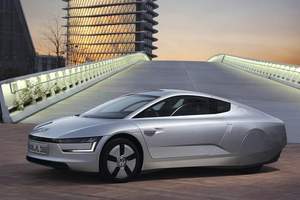
The headlines are not very positive. Elon Musk of Tesla contesting a negative review in the New York Times and delaying his next car, the Model X. Founder Henrik Fisker leaving his namesake EV company, which hasn’t produced cars for months. EV startup Coda Automotive laying off most of its staff and presumed almost out of business. Nissan Leaf sales declining year-to-year. the Chevy Volt being written off as a failure by many in the media because of failing to meet super-ambitious sales objectives and being seen as a financial drag on the company’s revival.
Overseas China has struggled with its “new energy” vehicles sales, falling short of government goals. The head of GM Europe complains that government representatives have clamored for electric vehicles, but have had a tepid response to the Ampera (the Opel version of the Volt). BMW announced it will offer free conventional vehicles to assuage range anxiety for purchasers of its electric i3 when it’s introduced next year.
While these headlines paint a grim picture for those who see the electrification of the automobile as a critical component for controlling the warming of the planet, the reality of the situation is not quite so negative.
The early market adoption of plug-in vehicles (pure battery electrics and those with internal combustion engines to supplement their electric drivetrain) is actually outpacing the adoption of hybrid vehicles, which after 12 years have become mainstream vehicles in many areas. The Nissan Leaf, the poster child for Nissan’s commitment to electric vehicles, topped 50,000 cumulative sales worldwide last month and is just starting to ramp up vehicle and battery production in the U.S. That shift in production from Japan to the U.S. is expected to help drop prices on the car while the company is also working on extending the range of its battery.
Nissan Points to China
Nissan, as reiterated by its CEO Carlos Ghosn as recently as this last week, remains committed to plug-in vehicles along with its European partner Renault. He indicated he thought China would be where the EV breakthrough would come. China’s goal of having 500,000 “new energy” vehicles (which includes hybrids as well as plug-ins) on the road by 2015, coupled with its centrally planned economy, may overcome the slow start up there. As of the end of 2012 only 23,000 of the new energy vehicles had been sold in the country.
Nissan is not alone, though, as every car company has vehicle electrification as part of their future product strategy. While many auto executives remain somewhere between skeptical and concerned about whether the consumer demand for these vehicles will meet planned production volumes, they are moving ahead with building the vehicles. The move is driven by auto companies’ need to meet American fuel economy standards and European CO2 reduction goals as well as similar moves around the globe.
Joining the Leaf, Volt, Tesla Model S, Toyota Prius Plug-in, Mitsubishi i, Ford C-Max Energi, Ford Focus EV, Ford Fusion Energi, Toyota RAV4 EV, Honda Accord Plug-in, Honda Fit EV, BMW ActiveE, Smart ED, Fisker Karma and Coda on the market will be new models from GM, VW, Fiat, BMW, Audi and Toyota. And others are likely to show up unannounced. Volumes may start low, but most companies are prepared to ramp up as needed.

In addition to the commitment of automakers, analysts following the industry also see the EV trend gaining steam. PwC surveys automotive suppliers as well as manufacturers annually and came to this conclusion:
“Continued investment to improve upon the electric vehicle value chain, along with the pace of advancement in competing alternative fuel solutions, will ultimately determine the level of success EVs are able to achieve, says Brandon Mason, a senior analyst with PwC’s Autofacts group. “While we don’t expect one to be parked in every driveway anytime soon, there is no doubt that EVs are here to stay.”
Autofacts predicts the global market share for EVs will be 6.3 percent in 2020, which may lean heavily on China achieving its cumulative 5 million “new energy” vehicles by that year. In the U.S., President Obama several years ago challenged the auto industry to put 1 million EVs on the road by 2015, but those numbers relied heavily on the clearly over-optimistic Volt, Leaf, Tesla Model S and Ford Focus sales projections as well as contributions from the Think City and Ford Transit Connect (no longer in production) and the Fisker Nina that may never go into production.
The bottom line is that plug-in cars are may not be selling as well as some proponents would like, but they’re also not going away as some detractors might wish. The slow but steady progression towards a more electrified automobile is a path on which the industry is set. The cars will keep coming. They will keep getting better. How soon and in what numbers consumers adopt them is the only part of the equation that is not determined.

2 thoughts on “Electric Vehicles: A Disconnect in 2013?”